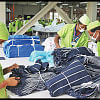Low spending on R&D alarming

Most industries in Bangladesh spend less than Tk 500 per year on research and development (R&D) per worker, according to the Centre for Policy Dialogue (CPD), a scenario that may hold back a country aiming to become a manufacturing hub and a developed nation in less than two decades.
Raising competitiveness and productivity through R&D and innovation are deemed as vital for nations that want to ensure sustainable wage growth, create jobs and stay ahead of competition in export markets.
A higher R&D spending also leads to higher innovation, which contributes to higher per capita income.
But in Bangladesh, the overall R&D investments stood at 0.03 percent of gross domestic product (GDP) in 2022-23, according to data of the planning commission. It was 0.54 percent in Vietnam, 0.70 percent in India, and 2.55 percent in China, World Bank data showed.
"In Bangladesh, the low spending on R&D is alarming," said the CPD in a study report.
However, the country's pharmaceuticals and allied industry spends the most among all industries, with per worker expenditure standing at Tk 23,735.
The think-tank shared the findings yesterday at a dialogue titled "Technology Use in the Manufacturing Industries of Bangladesh" at the Brac Centre Inn in the capital's Mohakhali.
The study was based on the data from the Bangladesh Bureau of Statistics' Manufacturing Industries Survey 2019 and the World Bank's Enterprise Survey 2022.
It said the "other transport equipment" sector spends Tk 2,001 for R&D while tobacco manufacturers' outlay stands at Tk 1,858, the paper industry's spending at Tk 1,627, and the textiles sector at Tk 436.
Some sectors such as recycling, beverage, wood, wood-based products, motor vehicles, trailers and semi-trailers, repair and installation of machinery and equipment don't spend any penny.
The share of firms' spending on R&D in each sector remains alarmingly low, the CPD said.
For the 'other services' sector, 5 percent of the firms spend on R&D, while in the food, textiles and other manufacturing sectors, only about 3 percent of firms allocate budget for R&D.
"The ratio is even lower for the garments industry as factories channel only 2 percent of their expenditures to R&D," the CPD said.
Only 1 percent of medium-sized firms have expenses related to R&D. Large firms direct 5 percent of their budget to the segment while it is 2 percent for small firms.
According to the study, a majority of manufacturing firms, located across the country, do not have a digital presence in the form of websites.
The CPD said the manufacturing sector largely focuses on low-tech products and it continues to be a significant contributor to the GDP growth. The lion's share of industry involves export, including that of readymade garments.
"In terms of competitiveness, Bangladesh lags behind other countries," said Fahmida Khatun, executive director of the CPD.
"Productivity per worker in Bangladesh is less than that of our competitors."
She said there is no alternative to using advanced technologies in the industrial sector for economic prosperity.
"If we can't keep pace with the way technology is being revolutionised all over the world, we will fall behind. There's a lot of talk about things, but it is not improving as expected."
"The need for skilled workforce will be crucial for the country after the graduation from the group of the least-developed countries in 2026."
Echoing CPD's findings, Zaki Uz Zaman, the country representative at the United Nations Industrial Development Organisation, said it also reflects the country's position in the global ranking.
Bangladesh came 102nd among 132 countries in the Global Innovation Index 2022 whereas India secured 40th position, Vietnam 48th and Thailand 43rd.
"Bangladesh was even behind Sri Lanka," he said.
Zaman said there is a shortage of spending on R&D in the manufacturing sector.
However, he credited the agriculture sector for higher R&D, which has made the country almost self-sufficient in food production.
Syed Almas Kabir, president of the Bangladesh-Malaysia Chamber of Commerce and Industry, underscored employing the capability of domestic firms.
He argued that Bangladesh has witnessed the implementation of many mega projects in recent times. Had local IT companies got some opportunity to work on those projects, the firms would have been on a sound footing.
He urged the government to formulate a national strategy to ensure a congenial climate for R&D and adopt advanced technologies.
"The government should also think of an alternative plan if existing workers become jobless because of the adoption of advanced technologies in the manufacturing sector."
Industries Minister Nurul Majid Mahmud Humayun said a collective effort from the private sector is needed to accelerate spending on R&D as it is not a waste of money.
"It is important to invest in the right place. If we don't invest in technologies and carry out quality research, we will continue to lag others."
Public and private universities would have to take responsibility to this effect, he said. "Quality education can't be ignored if skilled human resources are to be developed."
Syed Yusuf Saadat, a research fellow of the CPD, made a keynote presentation.

 For all latest news, follow The Daily Star's Google News channel.
For all latest news, follow The Daily Star's Google News channel. 








Comments